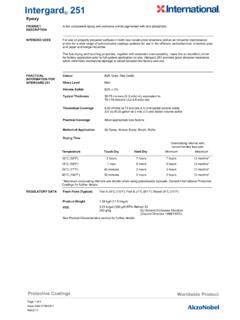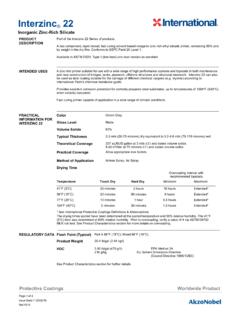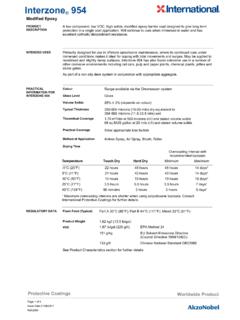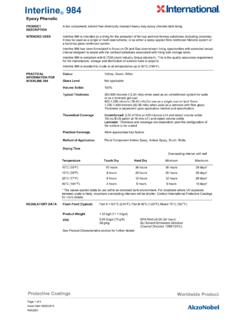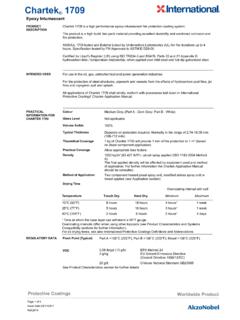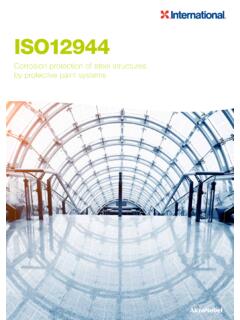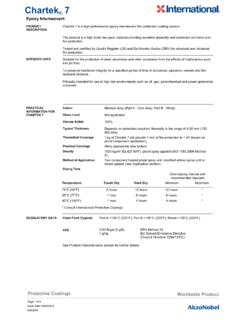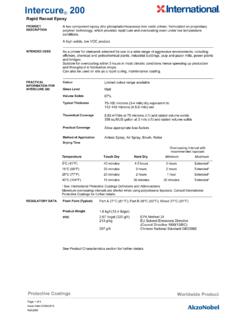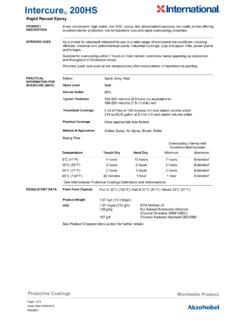Transcription of Interseal 670HS - AkzoNobel
1 Worldwide ProductPage 1 of 4 Issue Date: 22/01/2019 Ref:2394 Protective CoatingsInterseal 670HS Surface Tolerant EpoxyPRODUCT DESCRIPTIONA low VOC, two component high build, high solids surface tolerant epoxy maintenance USESFor application to a wide variety of substrates including hand prepared rusty steel, abrasive blast cleaned and hydroblasted steel, and a wide range of intact, aged coatings. Provides excellent anti-corrosive protection in industrial, coastal structures, pulp and paper plants, bridges and offshore environments in both atmospheric exposure and immersion FORINTERSEAL 670 HSColor Available in a wide range of colors including AluminumGloss Level Semi-gloss (Aluminum is eggshell)Volume Solids 82% 3% (depends on color)Typical Thickness 4-10 mils (100-250 microns) dry equivalent to mils (122-305 microns) wetTheoretical Coverage 263 gallon at 5 mils and stated volume solids m2/litre at 125 microns and stated volume solidsPractical Coverage Allow appropriate loss factorsMethod of Application Airless spray, Air spray, Brush, RollerDrying Time For curing at low temperatures, an alternative curing agent is available.
2 See Product Characteristics for details. Refers to situations where immersion is likely to occur Refer to atmospheric service only See International Protective Coatings Definitions & Abbreviations Maximum overcoating intervals are shorter when using polysiloxane topcoats. Consult International Protective Coatings for further DATAF lash Point (Typical) Base (Part A) 97 F (36 C) Curing Agent (Part B) 133 F (56 C) Mixed 91 F (33 C)Product Weight lb/gal ( kg/l)VOC 114 g/kg EU Solvent Emissions Directive (Council Directive 1999/13/EC) lb/gal (240 g/lt) EPA Method 24 151 g/lt Chinese National Standard GB23985 *#Overcoating Interval Interseal 670HS with SelfOvercoating Interval with recommended topcoatsTemperatureTouch DryHard DryMinMaxMax MinMaxMax #50 F (10 C) 8 hours32 hours32 hours6 weeksExtended*20 hours21 days12 weeks59 F (15 C)7 hours26 hours26 hours4 weeksExtended*14 hours14 days8 weeks77 F (25 C)5 hours18 hours18 hours14 daysExtended*10 hours7 days4 weeks104 F (40 C)
3 2 hours6 hours6 hours7 daysExtended*4 hours3 days2 weeksPage 2 of 4 Issue Date: 22/01/2019 Ref:2394 Protective CoatingsInterseal 670HS Surface Tolerant EpoxySURFACE PREPARATIONThe performance of this product will depend upon the degree of surface preparation . The surface to be coated should be clean, dry and free from contamination. Prior to paint application all surfaces should be assessed and treated in accordance with ISO 8504 dirt and soluble salts must be removed. Dry bristle brushing will normally be adequate for accumulated dirt. Soluble salts should be removed by fresh water Blast CleaningFor immersion service, Interseal 670HS must be applied to surfaces blast cleaned to (ISO 8501-1:2007) or SSPC-SP10. However, for atmospheric exposure best performance will be achieved when Interseal 670HS is applied to surfaces prepared to a minimum of (ISO 8501-1:2007) or defects revealed by the blast cleaning process, should be ground, filled, or treated in the appropriate surface profile of 2-3 mils (50-75 microns) is or Power Tool PreparationHand or power tool clean to a minimum St2 (ISO 8501-1:2007) or , all scale must be removed and areas which cannot be prepared adequately by chipping or needle gun should be spot blasted to a minimum standard of Sa2 (ISO 8501-1:2007) or SSPC-SP6.
4 Typically this would apply to C or D grade rusting in this High Pressure Hydroblasting/Abrasive Wet BlastingMay be applied to surfaces prepared to (ISO 8501-1:2007) or SSPC-SP6 which have flash rusted to no worse than Grade (refer to International Hydroblasting Standards) or Grade (refer to International Slurry blasting Standards). It is also possible to apply to damp surfaces in some circumstances. Further information is available from International Protective CoatingsInterseal 670HS is suitable for overcoating a limited range of intact, tightly adherent aged coatings. Loose or flaking coatings should be removed back to a firm edge. Glossy finishes may require light abrasion to provide a physical key . See Product Characteristics section for further Material is supplied in two containers as a unit. Always mix a complete unit in the proportions supplied.
5 Once the unit has been mixed it must be used within the working pot life specified. (1) Agitate Base (Part A) with a power agitator. (2) Combine entire contents of Curing Agent (Part B) with Base (Part A) and mix thoroughly with power Ratio parts : part by volumeWorking Pot Life 50 F (10 C) 59 F (15 C) 77 F (25 C) 104 F (40 C) 5 hours 3 hours 2 hours 1 hourAirless Spray Recommended Tip range 18-23 thou ( mm) Total output fluid pressure at spray tip not less than 2,500 (176 kg/cm2)Air Spray Recommended Gun DeVilbiss MBC or JGA(Pressure Pot) Air Cap 704 or 765 Fluid Tip EBrush Recommended Typically 4-5 mils (100-125 microns) can be achievedRoller Recommended Typically 3-4 mils (75-100 microns) can be achievedThinner International GTA220 Thinning is not normally required.
6 Consult the local representative for advice during application in extreme conditions. Do not thin more than allowed by local environmental legislation. Cleaner International GTA822 (or GTA415)Work Stoppages Do not allow material to remain in hoses, gun or spray equipment. Thoroughly flush all equipment with International GTA822. Once units of paint have been mixed they should not be resealed and it is advised that after prolonged stoppages work recommences with freshly mixed Up Clean all equipment immediately after use with International GTA822. It is good working practice to periodically flush out spray equipment during the course of the working day. Frequency of cleaning will depend upon amount sprayed, temperature and elapsed time, including any delays.
7 All surplus materials and empty containers should be disposed of in accordance with appropriate regional 2 of 4 Page 3 of 4 Issue Date: 22/01/2019 Ref:2394 Protective CoatingsInterseal 670HS Surface Tolerant EpoxyPRODUCTCHARACTERISTICSFor water immersion service, surface preparation to a minimum of (ISO 8501-1:2007) or SSPC-SP10 followed by application of multi-coats of Interseal 670HS to a total minimum dry film thickness of 10 mils (250 microns) is derived from chromascan bases as the first coat of a specification for immersion service is not recommended. Maximum film build in one coat is best attained by airless spray. When applying by methods other than airless spray, the required film build is unlikely to be achieved. Application by air spray may require a multiple cross spray pattern to attain maximum film build.
8 Low or high temperatures may require specific application techniques to achieve maximum film salt water is used in the wet blast process the resulting surface must be thoroughly washed with fresh water before application of Interseal 670HS . With freshly blasted surfaces a slight degree of flash rusting is allowable, and is preferable to the surface being too wet. Puddles, ponding and accumulations of water must be 670HS may be applied to suitably sealed or primed concrete; contact International Protective Coatings for further advice on specification and 670HS is suitable for overcoating intact, aged alkyd, epoxy and polyurethane systems. However, this product is not recommended where thermoplastic coatings such as chlorinated rubbers and vinyls have previously been used. Please consult International Protective Coatings for alternative temperature must always be a minimum of 5 F (3 C) above dew of sheen and surface finish is dependent on application method.
9 Avoid using a mixture of application methods whenever possible. In common with all epoxies Interseal 670HS will chalk and discolor on exterior exposure. However, these phenomena are not detrimental to anti-corrosive exposure to ponding water will cause a color change, especially in dark 670HS can be used as a non-skid deck system by modification with addition of GMA132 (crushed flint) aggregate. Application should then be to a suitably primed surface. Typical thicknesses will be between 20-40 mils (500-1,000 microns). Preferred application is by a suitable large tip hopper gun ( Sagola 429 or Air texture gun fitted with a 5-10 mm nozzle). Trowel or roller can be used for small areas. Alternatively, a broadcast method of application can be used. Consult International Protective Coatings for further Temperature CuringA winter grade curing agent is also available to enable more rapid cure at temperatures less than 50 F (10 C), however this curing agent will give an initial shade variation and more rapid discoloration on 670HS is capable of curing at temperatures below 32 F (0 C).
10 However, this product should not be applied at temperatures below 32 F (0 C) where there is a possibility of ice formation on the Interval Interseal 670HS with SelfOvercoating Interval with recommended topcoatsTemperatureTouch DryHard DryMinMax Max MinMax Max 23 F (-5 C) 24 hours72 hours72 hours12 weeksExtended*72 hours84 hours12 weeks32 F (0 C)16 hours56 hours56 hours10 weeksExtended*42 hours54 hours10 weeks41 F (5 C)9 hours36 hours36 hours8 weeksExtended*36 hours48 hours8 weeks50 F (10 C)5 hours24 hours24 hours6 weeksExtended*16 hours24 hours6 weeks Refers to situations where immersion is likely to occur Refer to atmospheric service only * See International Protective Coatings Definitions & Abbreviations Touch dry times shown above are actual drying times due to chemical cure, rather than physical set due to solidification of the coating film at temperatures below 32 F (0 C).
